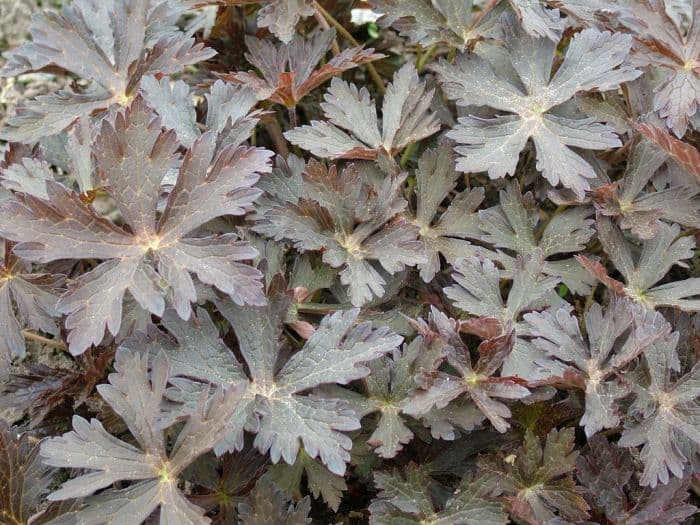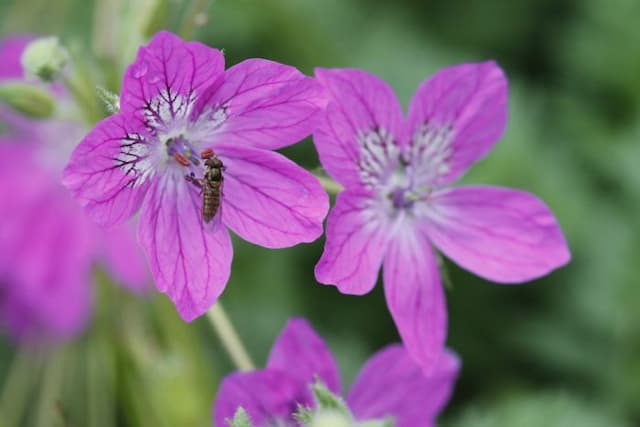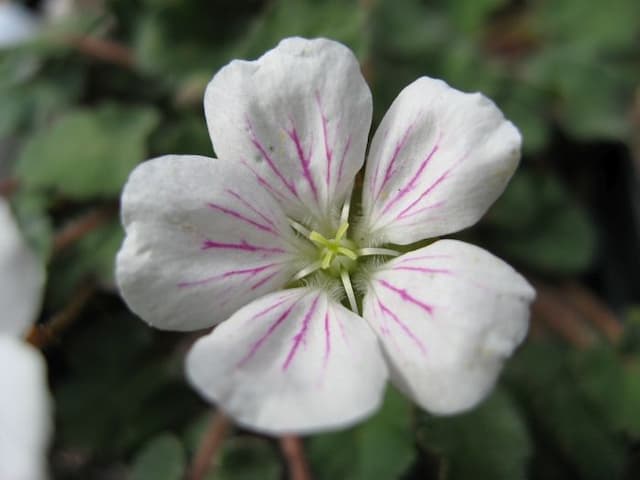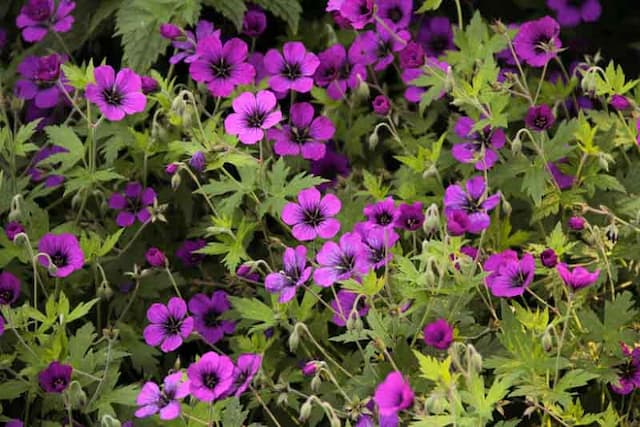Wild Geranium Geranium maculatum 'Elizabeth Ann' (PBR)

ABOUT
Geranium maculatum 'Elizabeth Ann', commonly known as wild geranium or spotted geranium, is a charming herbaceous perennial that boasts an appealing aesthetic. This variety distinguishes itself with its unique foliage and attractive flowers. The leaves are deeply lobed, resembling an intricately cut piece of art, with remarkable dark chocolate to purple-brown hues that set 'Elizabeth Ann' apart from the more green-toned foliage of its species. These leaves often maintain their color throughout the growing season, contributing to a rich, contrasting backdrop in garden spaces. In spring to early summer, the plant is adorned with delicate blooms that have an airy, whimsical demeanor. The flowers present a soft lavender-pink color, which exudes a pastel charm. Each bloom typically has five rounded petals, configured in a classic geranium shape, and these are set off by prominent veining and a lighter center, drawing the eye and adding depth to the floral display. The attractive foliage and blooms are joined by slender, branching stems that contribute to the plant's overall graceful appearance. 'Elizabeth Ann' adds texture and interest to shaded garden areas, filling spaces with its gentle color palette and inviting presence. The contrasting foliage and flowers make it a sought-after variety for gardeners looking to enhance their garden with long-lasting visual appeal.
About this plant
 Names
NamesFamily
Geraniaceae
Synonyms
Elizabeth Ann Cranesbill, Elizabeth Ann Wild Geranium, Elizabeth Ann Spotted Cranesbill
Common names
Geranium maculatum 'Elizabeth Ann' (PBR).
 Toxicity
ToxicityTo humans
Wild geranium is typically considered non-toxic to humans and is not known to cause serious symptoms of poisoning. Casual contact or incidental ingestion of small quantities is generally not harmful. However, eating large amounts of any non-food plant material can potentially cause some gastrointestinal upset due to the unusual compounds or natural plant defenses.
To pets
Wild geranium is generally regarded as non-toxic to pets as well. It is not known to be poisonous to dogs, cats, or other animals kept as pets. Ingesting this plant should not cause any significant symptoms of poisoning. However, as with many plants, ingestion of large amounts may possibly cause mild stomach upset in some pets due to the plant's fiber and natural compounds.
 Characteristics
CharacteristicsLife cycle
Perennials
Foliage type
Deciduous
Color of leaves
Green
Flower color
Pink
Height
1-2 feet (30-60 cm)
Spread
1-2 feet (30-60 cm)
Plant type
Herb
Hardiness zones
4
Native area
North America
Benefits
 General Benefits
General Benefits- Aesthetic Appeal: Adds a splash of color with its deep pink-purple flowers, enhancing the beauty of gardens.
- Attracts Pollinators: Invites bees and butterflies, which are essential for pollination and maintaining healthy ecosystems.
- Easy Care: Known for being low-maintenance and requiring minimal care once established.
- Drought Tolerance: Able to withstand periods of dry weather, making it suitable for xeriscaping or drought-prone areas.
- Shade Tolerance: Thrives in partially shaded areas where other sun-dependent plants might struggle.
- Seasonal Interest: Offers visual interest throughout its blooming season, typically in late spring to early summer.
- Naturalization: Over time, can spread and naturalize in an area, creating a fuller, more robust garden appearance.
- Deer Resistance: Less palatable to deer, which can help prevent damage to the plant and surrounding flora.
- Soil Adaptability: Can grow in a wide range of soil types, from well-draining to clay soils.
 Medical Properties
Medical PropertiesThis plant is not used for medical purposes.
 Air-purifying Qualities
Air-purifying QualitiesThis plant is not specifically known for air purifying qualities.
 Other Uses
Other Uses- Photography Prop: The attractive foliage and blooms of the Geranium maculatum can serve as a beautiful backdrop in garden photography, adding depth and interest to the composition.
- Dye Source: Historically, some geranium species have been used to create dyes, and Geranium maculatum's richly colored leaves and flowers could potentially be used for natural fabric dyeing.
- Educational Tool: The plant can be used in botany lessons for students learning about native plant species, pollination, and plant reproduction.
- Artistic Inspiration: Artists may use the wild geranium as a subject for painting or drawing, captivated by its intricate details and textures.
- Garden Design: With its attractive foliage, this geranium can be used for its textural contrast in shade gardens or woodland settings.
- Culinary Garnish: While the common wild geranium is not widely known for culinary uses, the flowers could potentially be used as an edible garnish on desserts or salads after proper identification and safety considerations.
- Craft Projects: The flowers and leaves can be pressed and used in craft projects like making bookmarks, greeting cards, or decoupage.
- Floral Arrangements: The Geranium maculatum can be included in cut floral arrangements to provide a natural and whimsical feel.
- Companion Planting: This plant could be used in companion planting to provide ground cover and support beneficial insect populations in the garden.
- Relaxation: The natural beauty of the Geranium maculatum may contribute to a calming environment for outdoor yoga or meditation spaces.
Interesting Facts
 Feng Shui
Feng ShuiThe plant Cranesbill is not used in Feng Shui practice.
 Zodiac Sign Compitability
Zodiac Sign CompitabilityThe plant Cranesbill is not used in astrology practice.
 Plant Symbolism
Plant Symbolism- Friendship: The geranium is often associated with positive emotions and thus symbolizes friendship and companionship.
- Health: This plant is known for its healing properties in herbal medicine, making it a symbol of health and recovery.
- Happiness: With its bright flowers and pleasant fragrance, geraniums are often linked to happiness and positive vibes.
- Fertility: In some cultures, the geranium represents fertility and the creation of new life due to its prolific nature.
- Protection: Geraniums are believed to have protective qualities, keeping negative energies and spirits away.
 Water
WaterThe cranesbill, commonly known as 'Elizabeth Ann', should be watered deeply once a week during active growth, particularly in the absence of rain. This ensures that the soil is moist but not waterlogged. During periods of drought or high heat, increase the frequency to twice a week. Provide approximately one gallon of water per plant each time you water, ensuring it reaches the root zone. In winter, reduce watering significantly as the plant requires less moisture during dormancy.
 Light
Light'Elizabeth Ann' cranesbill thrives in partial shade, although it can tolerate full sun in cooler climates. For best results, locate the plant in a spot that receives morning sunlight and afternoon shade. This will prevent the leaves from scorching while still providing adequate light for healthy growth.
 Temperature
Temperature'Elizabeth Ann' cranesbill is hardy and can withstand a broad range of temperatures, typically thriving in conditions between 60°F and 75°F. It can survive minimum temperatures down to around 20°F, making it suitable for many temperate regions. However, it prefers not to be exposed to prolonged periods of heat above 85°F.
 Pruning
Pruning'Elizabeth Ann' cranesbill benefits from pruning to remove dead or faded flowers and foliage, which encourages new growth and prolongs blooming. Prune lightly throughout the blooming season as needed, and perform a more thorough cutback in late autumn or early spring to prepare for new growth. The best time for major pruning is after the last frost in spring.
 Cleaning
CleaningAs needed
 Soil
SoilThe best soil mix for the wild geranium 'Elizabeth Ann' is well-draining, moist, and rich in organic matter. A blend of peat, garden soil, compost, and a bit of sharp sand or perlite can provide excellent drainage and nutrients. The pH should be slightly acidic to neutral, ranging from 5.5 to 7.0.
 Repotting
RepottingWild geranium 'Elizabeth Ann' should be repotted every 2-3 years or when it outgrows its current pot. Gently tease out the roots and place in a larger pot with fresh soil mix to ensure continued growth.
 Humidity & Misting
Humidity & MistingThe wild geranium 'Elizabeth Ann' prefers moderate to high humidity levels but is quite adaptable to average home humidity. To maintain optimal conditions, aim for about 40-50% humidity for this plant.
 Suitable locations
Suitable locationsIndoor
Place in bright, indirect light and water moderately.
Outdoor
Part shade, moist soil, protect from hot afternoon sun.
Hardiness zone
4-8 USDA
 Life cycle
Life cycleGeranium maculatum 'Elizabeth Ann', commonly known as Elizabeth Ann Wild Cranesbill, begins its life cycle as a seed, often sown in the cooler months, after stratification which may enhance germination. Upon germination, seedlings emerge and gradually develop into juvenile plants, forming a rosette of lobed leaves. As the plant matures, it enters the vegetative stage, producing a clump of foliage and elongating stems. It reaches the flowering stage in late spring to early summer, presenting striking, deep purple-pink, veined flowers that attract pollinators. After pollination, the flowers develop into beak-like seed capsules that eventually disperse seeds, completing the reproductive cycle. In fall, the plant may die back, entering a period of dormancy, especially in colder climates, but the rootstock will survive to regenerate the following spring.
 Propogation
PropogationPropogation time
Spring to Summer
For Geranium maculatum 'Elizabeth Ann', also known as wild geranium or spotted cranesbill, propagation is most effectively accomplished through division. The best time to do this is either in the spring or fall when the plant is not actively flowering. To propagate by division, carefully dig up the plant and gently separate the rhizomes, ensuring each section has a portion of the root and at least one shoot. Replant the divisions immediately at the same soil depth they were originally growing at, spacing them about 12 to 24 inches apart (30 to 60 cm). Water the new plants well to help establish them. This method maintains the unique characteristics of the 'Elizabeth Ann' cultivar, ensuring the offspring are true to the parent plant.









![Cranesbill [Rothbury Gem]](/_next/image?url=https%3A%2F%2Fplants-admin.emdemapps.com%2Fimages%2Fplants%2F%2Fimages%2F604b6243984c2.png&w=640&q=75)